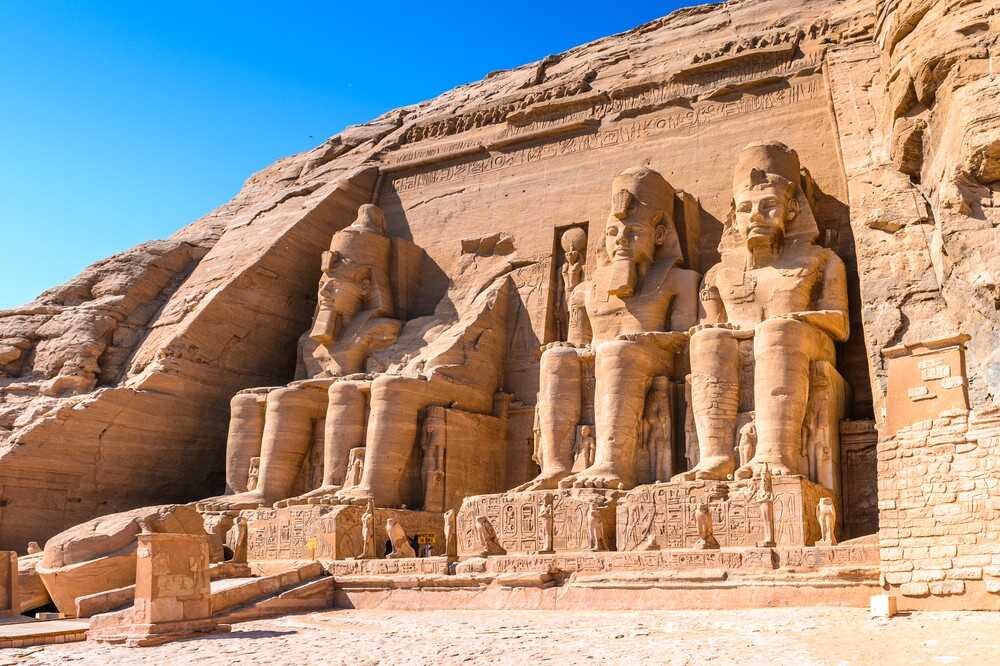Cultural, historical, adventure, and custom customized trips are just a few of the tours that Deluxe trips offer in Egypt and Jordan.

Located on the Egyptian border with Sudan in the south, Abu Simbel Temples are Egypt's most famous and spectacular tourist attraction. Constructed as an homage to Egypt's great Pharaoh Ramses II, these rock-carved temples are not just works of architecture but also a display of power, divinity, and heritage. They leave tourists and historians in awe even today with their giant statues, breathtakingly beautiful interior chambers, and astronomical precision.
Abu Simbel belonged to the 13th century BCE during Egypt's New Kingdom. Ramses II built the complex, comprising two temples:
The Great Temple, dedicated to Ramses II himself and the gods Amun, Ra-Horakhty, and Ptah.
The Small Temple, dedicated to his favorite queen, Nefertari, and the goddess Hathor.
Both religious and political, they glorified Egypt's domination of Nubia and the pharaoh's dynasty.
The entrance facade of the Great Temple is among Egypt's most photographed spots. Four gigantic statues of Ramses II, measuring more than 20 meters high, proudly fill the entrance. Their enormity was meant to awe and announce the pharaoh's divine claim.
Inside, the visitors are greeted by a sequence of hypostyle halls, which are packed with meticulously decorated carvings that depict battles, religious processions, and offerings to gods.
Another of the magnificent elements is the inner sanctum, where the figurines of the gods are arranged in precise order. This leads our eyes to one of the most amazing aspects of the temple—its solar alignment.
Every year once—February 22 and October 22—the sunbeams travel through the innermost sanctuary of the temple and illuminate the seated forms of Ramses II, Ra-Horakhty, and Amun. The underworld god Ptah is left in darkness alone.
This celestial alignment was no accident. It reflects the advanced astronomical knowledge and architectural precision of ancient Egyptian builders. These dates are believed to mark Ramses II’s birthday and coronation day, making them significant religious and political events.
While the Great Temple is where the fame lies, the Small Temple is every bit as stunning. One of the few temples in Egypt built to a queen—Nefertari—it shows her on the same level as the king in the frescoes, a privilege reserved for very few in ancient Egypt.
Beautiful reliefs of the queen and gods inside the temple, and there is a sense of femininity and beauty.
In the 1960s, construction of the Aswan High Dam would have buried Abu Simbel beneath Lake Nasser. International intervention under UNESCO saved the monument.
Between 1964 and 1968, the entire complex was cut into gigantic blocks, relocated 65 meters higher up the hill, and reassembled—a monumental achievement of engineering and a credit to international cooperation.
This rescue operation not only saved Abu Simbel but set the world standard for heritage protection.
Abu Simbel should not be overlooked by any traveler to Egypt. The majority of tourists visit by:
Domestic air from Aswan (45 minutes)
Private overland tours, 3–4 hours by vehicle
Tours tend to start early morning to avoid the heat and have time enough to travel to the site and back.
Tip: Pair your stop with a visit to Aswan sights such as Egypt's Philae Temple or the Kom Ombo Temple for an extended Upper Egypt tour.
What makes Abu Simbel stand out is not only the scale—it's the visionary artistry, mythological narrative, and astronomical expertise that it embodies. The temples are a testament to the might of Ramses II, the significance of ancient Nubia, and the religious harmony of ancient Egypt.
Overall, Abu Simbel is not merely a monument—it's an eternal emblem of Egyptian ingenuity, cultural pride, and human determination.
Discover now our answers to the most common questions that may come to your mind about tourism and trips to Egypt
Cultural, historical, adventure, and custom customized trips are just a few of the tours that Deluxe trips offer in Egypt and Jordan.
The Dead Sea, Petra in Jordan, the Pyramids of Giza, Luxor's historic temples, and many other famous sites can be expected to be explored with Deluxe Tours.
offer a hassle-free holiday, Deluxe Tours' packages generally include lodging, transport, meals, guided tours with experienced local experts, and entry fees to attractions.
Spring (March to May) and fall (September to November) offer the finest weather for sightseeing and outdoor activities, making those months the best times to visit Egypt and Jordan.
These two countries are close by, only a 1.5-hour flight apart, and when combined, offer a variety of distinctive experiences. We advise you to spend at least 12 days visiting both countries for a truly unforgettable experience
Combining the eclipse viewing with visits to historic sites like the Pyramids of Giza, the Valley of the Kings, and a Nile River cruise are highly recommended.
